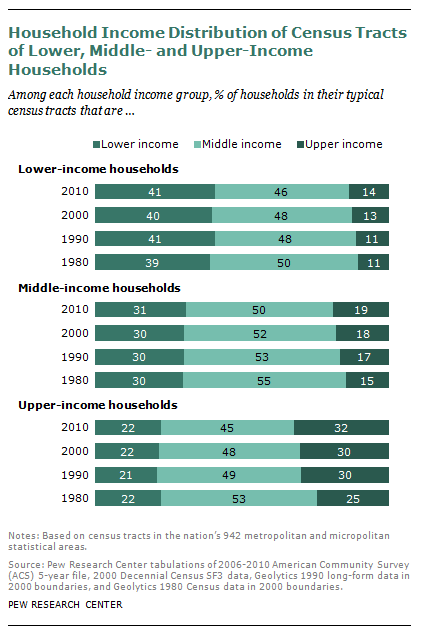 In 2010, the average lower-income household resided in a tract composed of 41% lower-income households and 14% upper-income households. In contrast, the typical upper-income household resided in a tract composed of 22% lower-income households and 32% upper-income households. The typical middle income household resided in a census tract that had 31% lower-income households and 19% upper-income households.
In 2010, the average lower-income household resided in a tract composed of 41% lower-income households and 14% upper-income households. In contrast, the typical upper-income household resided in a tract composed of 22% lower-income households and 32% upper-income households. The typical middle income household resided in a census tract that had 31% lower-income households and 19% upper-income households.
Since 1980, lower-income households have become increasingly likely to live in tracts with more lower-income households. In 2010, the average lower-income household resided in a tract with 41% lower-income households, an increase from 39% in 1980.
Likewise, since 1980 upper-income households have become increasingly likely to live in a tract with other upper-income households. In 2010, the average upper-income household resided in a tract composed of 32% upper-income households, an increase from 25% in 1980.
However, the Pew Research Center analysis of the composition of census tracts by income class is not entirely consistent with what some observers5 have dubbed a “secession of the successful” to describe the changing configuration of neighborhoods in recent decades. Though the typical upper-income household is more likely to live alongside other upper-income households, more than two-thirds of the neighbors of the typical upper-income household in 2010 were either middle income or lower-income households.
 Moreover, rather than distancing themselves from the poor, upper-income households have the same degree of exposure to lower-income households as in 1980. In 2010, the typical census tract of upper-income households was composed of 22% lower-income households, unchanged from the 1980 level.
Moreover, rather than distancing themselves from the poor, upper-income households have the same degree of exposure to lower-income households as in 1980. In 2010, the typical census tract of upper-income households was composed of 22% lower-income households, unchanged from the 1980 level.
Finally, upper-income households are not the only group that is increasingly exposed to other upper-income households. Lower and middle-income households are also increasingly likely to live in a census tract with more upper-income households. For example, in 2010 the typical lower-income household was located in a tract having 14% upper-income households, an increase from 11% in 1980. Upper-income households have grown at a faster rate than other income groups over the past several decades, and thus all groups are more likely to be exposed to them.


 Residential Income Segregation Maps of Top 10 U.S. Metro Areas
Residential Income Segregation Maps of Top 10 U.S. Metro Areas